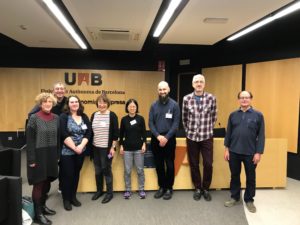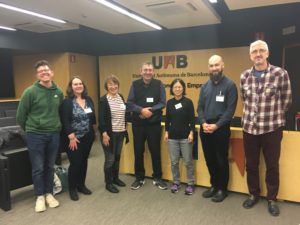The Bridging AI and Cognitive Science workshop at ICLR 2020 is being held virtually on April 26th. UMass’s Carolyn Anderson and Tessa Patapoutian will be presenting a paper titled “Can Neural Network Models Learn Spatial Perspective from Text Alone?” and Max Nelson will be presenting a paper titled “Learning Hierarchical Syntactic Transformations with Encoder-Decoder Networks.” Full papers, and details on virtually attending, can be found at: https://baicsworkshop.github.io/
Category Archives: Computational linguistics
Doucette starting PhD at McGill
Amanda Doucette, a recent graduate of our undergraduate program, will be starting a PhD at McGill University in the fall. Congratulations Amanda!
Hughto takes a position as a data engineer
Coral Hughto has been working since September as a Data Engineer at Assurance, a company in Seattle that provides a platform for buying insurance. Congratulations Coral!
Linzen colloquium Friday April 17 at 3:30
Tal Linzen, Johns Hopkins University, will present “What inductive biases enable human-like syntactic generalization?” in the Linguistics zolloquium series at 3:30 Friday April 17. An abstract follows. All are welcome! The Zoom link has already beensent out on department mailing lists. If you did not receive it and would like attend, please email Brian Dillon for the link.
Anderson to Wellesley
Congratulations are in order for Carolyn Anderson, who has accepted a tenure-track assistant professor position at Wellesley College in the Department of Computer Science. She’ll begin in the Fall of 2021. Best of luck at Wellesley, Carolyn! We’re proud of you and we look forward to seeing what you get up to out there.
Jarosz in Warsaw
On February 6th, Gaja Jarosz gave an invited talk at the Old World Conference in Phonology in her hometown of Warsaw, Poland. The talk, titled “Embracing Ambiguity: Quantitative Modeling in Phonology“, was live-streamed on YouTube and also made available on StreamGram.
Prickett in Phonology
Brandon Prickett has just published “Learning biases in opaque interactions” in the latest issue of Phonology. Congratulations Brandon!
https://doi.org/10.1017/S0952675719000320
Abstract
This study uses an artificial language learning experiment and computational modelling to test Kiparsky’s claims about Maximal Utilisation and Transparency biases in phonological acquisition. A Maximal Utilisation bias would prefer phonological patterns in which all rules are maximally utilised, and a Transparency bias would prefer patterns that are not opaque. Results from the experiment suggest that these biases affect the learnability of specific parts of a language, with Maximal Utilisation affecting the acquisition of individual rules, and Transparency affecting the acquisition of rule orderings. Two models were used to simulate the experiment: an expectation-driven Harmonic Serialism learner and a sequence-to-sequence neural network. The results from these simulations show that both models’ learning is affected by these biases, suggesting that the biases emerge from the learning process rather than any explicit structure built into the model.
UMass at RecPhon 2019
Many UMass folks past and present were at RecPhon 2019: Recursivity
in phonology below and above the word, 21-22 November 2019, Universitat Autònoma de Barcelona, Bellaterra. A number of former UMass visitors were co-organizers: Eulàlia Bonet, Joan Mascaró, Francesc Torres-Tamarit.
Invited speakers and UMass alumni Junko Ito and Armin Mester presented Recursivity in phonology below the word, while invited speaker and UMass alumna Emily Elfner presented Match Theory and Recursion below and above the word: Evidence from Tlingit. Faculty member Kristine Yu presented Computational perspectives on phonological constituency and recursion and graduate student Leland Kusmer presented Minimal prosodic recursion in Khoekhoegowab. Former visitor Gorka Elordieta presented joint work with emeritus faculty member Lisa Selkirk: Phrasing unaccented words in a recursive prosodic structure in Basque.
SENSUS at UMass, April 18-19, 2020
UMass is hosting “Sensus: Constructing meaning in Romance” on April 18-19, 2020. This is a conference on the formal semantics and pragmatics of Romance languages.
Areas: theoretical semantics and pragmatics and their interfaces with other domains, experimental methodologies, fieldwork, the study of variation and computational approaches
Venue: Integrative Learning Center at UMass Amherst (the ILC is a fully accessible building)
Invited speakers:
(McGill University)

Mariapaola D’Imperio
(Rutgers University)

Donka Farkas
(UC, Santa Cruz)

Organizers: Ana Arregui, María Biezma, Vincent Homer and Deniz Özy?ld?z
Event sponsored by the Department of Linguistics and the Department of Languages, Literatures and Cultures of UMass Amherst
Contact us at sensus@umass.edu
Details can be found here: http://websites.umass.edu/sensus/
David Smith talk, Monday Nov 18
David Smith (https://www.khoury.northeastern.edu/people/david-smith/) will present “Textual Criticism as Language Modeling: Viral Texts, Networked Authors, and Computational Models of Information Propagation” at 4 pm Monday Nov. 18th in ILC N400. An abstract is below.
This presentation is to a joint meeting of the Initiative for Data Science in the Humanities, and the Data Science tea. If you have any questions, contact Joe Pater at pater@umass.edu. David will be available for half hour meetings from 1 – 3:30 in the Linguistics department – sign up here.
Abstract
The era of mass digitization seems to provide a mountain of source material for scholarship, but its foundations are constantly shifting. Selective archiving and digitization obscures data provenance, metadata fails to capture the presence of texts of mutable genres and uncertain authorship embedded within the archive, and automatic optical character recognition (OCR) transcripts contain word error rates above 30% for even eighteenth-century English. The condition of the mass-digitized text is thus closer to the manuscript sources of an edition than to a scholarly publication. On the computational side, models that treat collections as sets of independent documents fail to capture the processes by which new texts are generated from existing ones.
In this talk, I will discuss several aspects of our work on “speculative bibliography” with computational methods. Starting from a simple model of the composition of historical newspaper pages, with applications to text denoising, I describe models of how texts transform their sources, applied to modern science journalism, medieval Arabic historians, and the generically hybrid forms in nineteenth-century newspapers. I conclude by discussing methods for inferring network structure and mapping information propagation among texts and publications.
This is joint work with Ryan Cordell, Rui Dong, Ansel MacLaughlin, Abby Mullen, Ryan Muther, and Shaobin Xu.


